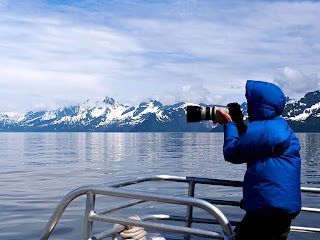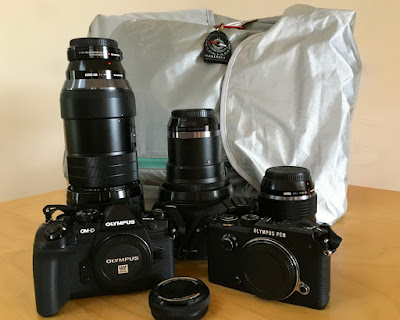Downsized my camera gear after a 2012 Alaska trip. Carried my Canon 7D DSLR (with EOS f/4.5-5.6L IS 100-400 mm), while my son had the new Olympus EM5 (with Lumix lens). Started this to share my experience with the new micro 4/3s format. If you're thinking of downsizing to micro 4/3s follow my journey scroll down (backwards in time). American Birding Association Birders' Exchange is a great place to donate your old camera gear.
October 29, 2013

My trusty birding camera has been a Canon 7D with EOS 100 - 400 mm (offering a 35 mm equivalent of 160 - 640 mm). I now have a smaller and lighter birding kit: An Olympus OM-D E-M5 with M.Zuiko 75 - 300 mm lens (offering a 35 mm equivalent of 150 to 600 mm--the E-M5's digital tele-converter provides a zoom range to 1200 mm).
Observations from my first birding trip (the American Birding Association's San Diego Birding Rally) with my E-M5:
(a) Carrying a smaller and lighter camera with binoculars is a neck- and shoulder-saver.
(b) The tele-converter 1200 mm can provide great "snapshots" for identification and/or photos for one's bird list.
(c) Focus lock can be tricky at 1200 mm. Focusing on a larger adjacent object and/or manual focus required.
(d) Auto focus tracking is limited; thus, capturing birds in flight was very difficult.
(e) The 7D with 100 - 400 at 400mm is easier to hold steady compared to the E-M5 with tele-converter at 1200 mm. Using a high frame (burst) rate increased the likelihood of capturing the target in-frame and in-focus.
Examples of photos taken with tele-coverter 1200 mm (left image) juxtaposed with a "close-up" crop (right image).







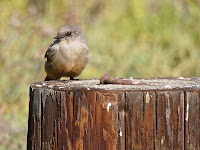
December 2015--My micro 4/3s Olympus gear is compact, light and versatile—never gets in the way. I’m now shooting with a fast and very sharp M.Zuiko f/2.8 40 to 150mm (80 to 300mm 35mm equivalent) lens.
Mexican Jay
Silver City NM
 |
| Original image 150mm ISO 320 f/2.8 1/1600 35mm equivalent of 300mm |
 |
| and cropped |
This lens has less reach than either my Canon 100 to 400 mm (f/4.5-5.6 160 to 640mm APSC 35mm equivalent) or Olympus M.Zuiko 75 to 300mm (f/4.8-6.7 150 to 600mm 35mm equivalent) zooms. If desired, increased “range” is achieved by using the camera’s digital teleconverter (mentioned earlier) permitting 160 to 600mm range.
Digital teleconverter photos:
Forster's Tern
Seal Beach Pier CA
 |
| Original digital teleconverter image 300mm ISO 200 f/2.8 1/3200 35mm equivalent of 600mm |
 |
| and cropped |
A camera software update permitting smaller autofocus targets (standard on the newer OMD EM5 Mk2 and EM1 PRO cameras) has mitigated issues discussed previously.
Auto focus tracking is still limited in my three year Olympus OMD EM5; presumably improved in newer models.
The range of the M.Zuiko f2.8 40-150 zoom can also be extended by using a 1.4x teleconverter, but its pricey.
Still have the slower 75-300mm lens for special use cases. This lens is very small and easy to pack--performs best with lots of light.
April 2017--New camera (Oympus EM1II), lens (300 mm f/4.0; 600 mm 35 mm equivalent) and 1.4x telecoverter (extending the forenamed lens to 840 mm 35 mm equivalent). The Blue Heron photo taken hand-held with the forenamed camera lens combination--the image stabilization is amazing.
Northern Cardinal far from normal range—maybe an escapee. Backlit hand-held at 840/35 mm equivalent.
and cropped
Allen's-hand-held at 840/35 mm equivalent
and cropped
A Cormorant taken with the 1.4 converter mated with the f/2.8 40 to 150 mm offering a
35 mm equivalent of 112 to 420 mm--this photo was taken at 420 mm.

EM1II with M.Zuiko 300 mm f/4.0 juxtaposed to my Canon 7D
with EOS 100 - 400 mm f/4.5-5.6.
 |
| My "prime kit" carry is a Peak Design Pouch |
 |
| Peak Design Backpack for traveling and their Everyday Sling for more general use. |
July 2017 Camera gear for Barrow and Dutch Harbor Alaska.
Timbuk2 (20L) waterproof back-pack.
South Florida with High Lonesome Bird Tours in May 2018.
Avid birders/photographers in our group with "full-frame" equipment.
My micro 4/3s gear quite diminutive by comparison.
Photos of some of our target birds below
 |
| E-M1 Mark2 M.300mm f4.0+MC-14 (uncropped) |
Spot-Breasted Oriole
 |
| E-M1 Mark2 M.300mm f4.0+MC-14 (uncropped) |
Snail Kite
 |
| E-M1 Mark2 M.300mm f4.0+MC-14 (uncropped) |
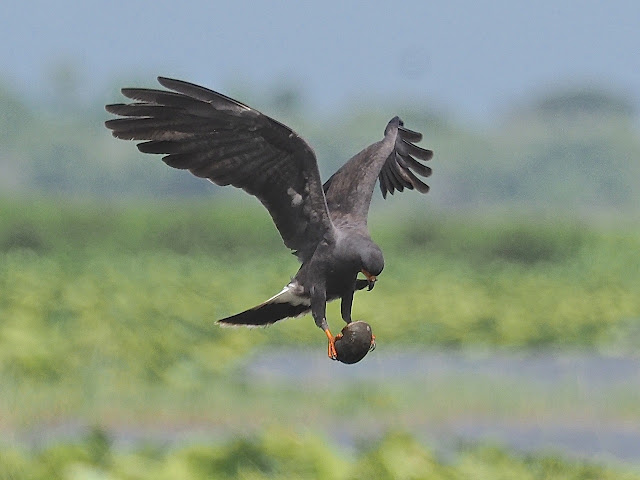 |
| E-M1Mark2 M.300mm f4.0+MC-14 (cropped) |
Link to more South Florida photos: http://dwkee.blogspot.com/2018/05/south-florida-with-high-lonesome-bird.html
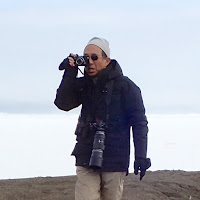
Weather in South Florida was quite a contrast from our High Lonesome trip to Barrow last year.
 |
| First photo shows my relative location to seal hunters. Second and last taken with E-M1 M2 with M.300mm f4.0/MC-14: Original size and cropped, respectively. |
See my most recent photos here--https://dwkee.blogspot.com/2020/10/birding-snapshots.html

